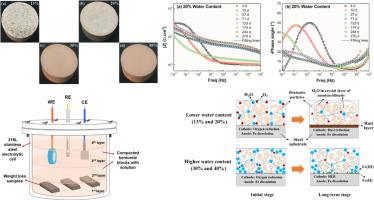当前位置:
X-MOL 学术
›
J. Mater. Sci. Technol.
›
论文详情
Our official English website, www.x-mol.net, welcomes your
feedback! (Note: you will need to create a separate account there.)
Effects of water content on the corrosion behavior of NiCu low alloy steel embedded in compacted GMZ bentonite
Journal of Materials Science & Technology ( IF 11.2 ) Pub Date : 2024-11-01 , DOI: 10.1016/j.jmst.2024.08.070 Madhusudan Dhakal, Xin Wei, Hari Bhakta Oli, Nan Chen, Yupeng Sun, Durga Bhakta Pokharel, Qiying Ren, Junhua Dong, Wei Ke
Journal of Materials Science & Technology ( IF 11.2 ) Pub Date : 2024-11-01 , DOI: 10.1016/j.jmst.2024.08.070 Madhusudan Dhakal, Xin Wei, Hari Bhakta Oli, Nan Chen, Yupeng Sun, Durga Bhakta Pokharel, Qiying Ren, Junhua Dong, Wei Ke

|
Buffer material and metal disposal containers are the key engineering barriers in the geological disposal of high-level radioactive waste. The durability of disposal containers largely depends on the water content in buffer material. This work focused on investigating the corrosion evolution of NiCu low alloy steel in compacted GMZ bentonite with different water contents for 270 d by using weight loss, electrochemical measurements, and various methods for analyzing corrosion products. As the water content increased from 13% to 20%, the water in the bentonite transformed from an unsaturated to a critical saturated state, and the corrosion rate of NiCu steel clearly increased. In these two systems, the oxygen could migrate to the thin liquid film on the steel surface through the air pores in the bentonite in the gas phase and undergo cathodic reduction. Meanwhile, it oxidized the ferrous hydrolysis products into ferric corrosion products and formed a rust layer, which could block the diffusion of oxygen. At that moment, the cathodic process of NiCu steel corrosion changed to rust reduction. When the water content continually increased to 30% and 40%, the compacted bentonite was in a saturation state, and the corrosion rate of NiCu steel was significantly decreased. This was because most pores among the bentonite particles were occupied by a large amount of free water, which hindered the diffusion of oxygen and inhibited its cathodic reduction. Furthermore, it restrained the oxidation of ferrous corrosion products, which greatly weakened the cathodic depolarization of rust, leading to the cathodic process being dominated by the hydrogen evolution reaction.
中文翻译:

含水率对 NiCu 低合金钢嵌入压实 GMZ 膨润土腐蚀行为的影响
缓冲材料和金属处置容器是高水平放射性废物地质处置中的关键工程屏障。处理容器的耐用性在很大程度上取决于缓冲材料中的水分含量。本工作侧重于使用失重、电化学测量和各种腐蚀产物分析方法,研究 NiCu 低合金钢在不同含水量的压实 GMZ 膨润土中 270 d 的腐蚀演变。随着含水率从 13% 增加到 20%,膨润土中的水分由不饱和状态转变为临界饱和状态,NiCu 钢的腐蚀速率明显增加。在这两个系统中,氧气可以通过气相中膨润土中的气孔迁移到钢表面的薄液膜上,并发生阴极还原。同时,它将亚铁水解产物氧化成铁腐蚀产物并形成锈层,可以阻止氧气的扩散。那一刻,NiCu 钢腐蚀的阴极过程转变为除锈。当含水率不断增加到 30% 和 40% 时,压实膨润土处于饱和状态,NiCu 钢的腐蚀速率显著降低。这是因为膨润土颗粒中的大多数孔隙被大量的游离水占据,阻碍了氧的扩散并抑制了其阴极还原。此外,它抑制了铁腐蚀产物的氧化,大大削弱了铁锈的阴极去极化,导致阴极过程以析氢反应为主。
更新日期:2024-11-01
中文翻译:

含水率对 NiCu 低合金钢嵌入压实 GMZ 膨润土腐蚀行为的影响
缓冲材料和金属处置容器是高水平放射性废物地质处置中的关键工程屏障。处理容器的耐用性在很大程度上取决于缓冲材料中的水分含量。本工作侧重于使用失重、电化学测量和各种腐蚀产物分析方法,研究 NiCu 低合金钢在不同含水量的压实 GMZ 膨润土中 270 d 的腐蚀演变。随着含水率从 13% 增加到 20%,膨润土中的水分由不饱和状态转变为临界饱和状态,NiCu 钢的腐蚀速率明显增加。在这两个系统中,氧气可以通过气相中膨润土中的气孔迁移到钢表面的薄液膜上,并发生阴极还原。同时,它将亚铁水解产物氧化成铁腐蚀产物并形成锈层,可以阻止氧气的扩散。那一刻,NiCu 钢腐蚀的阴极过程转变为除锈。当含水率不断增加到 30% 和 40% 时,压实膨润土处于饱和状态,NiCu 钢的腐蚀速率显著降低。这是因为膨润土颗粒中的大多数孔隙被大量的游离水占据,阻碍了氧的扩散并抑制了其阴极还原。此外,它抑制了铁腐蚀产物的氧化,大大削弱了铁锈的阴极去极化,导致阴极过程以析氢反应为主。


















































 京公网安备 11010802027423号
京公网安备 11010802027423号